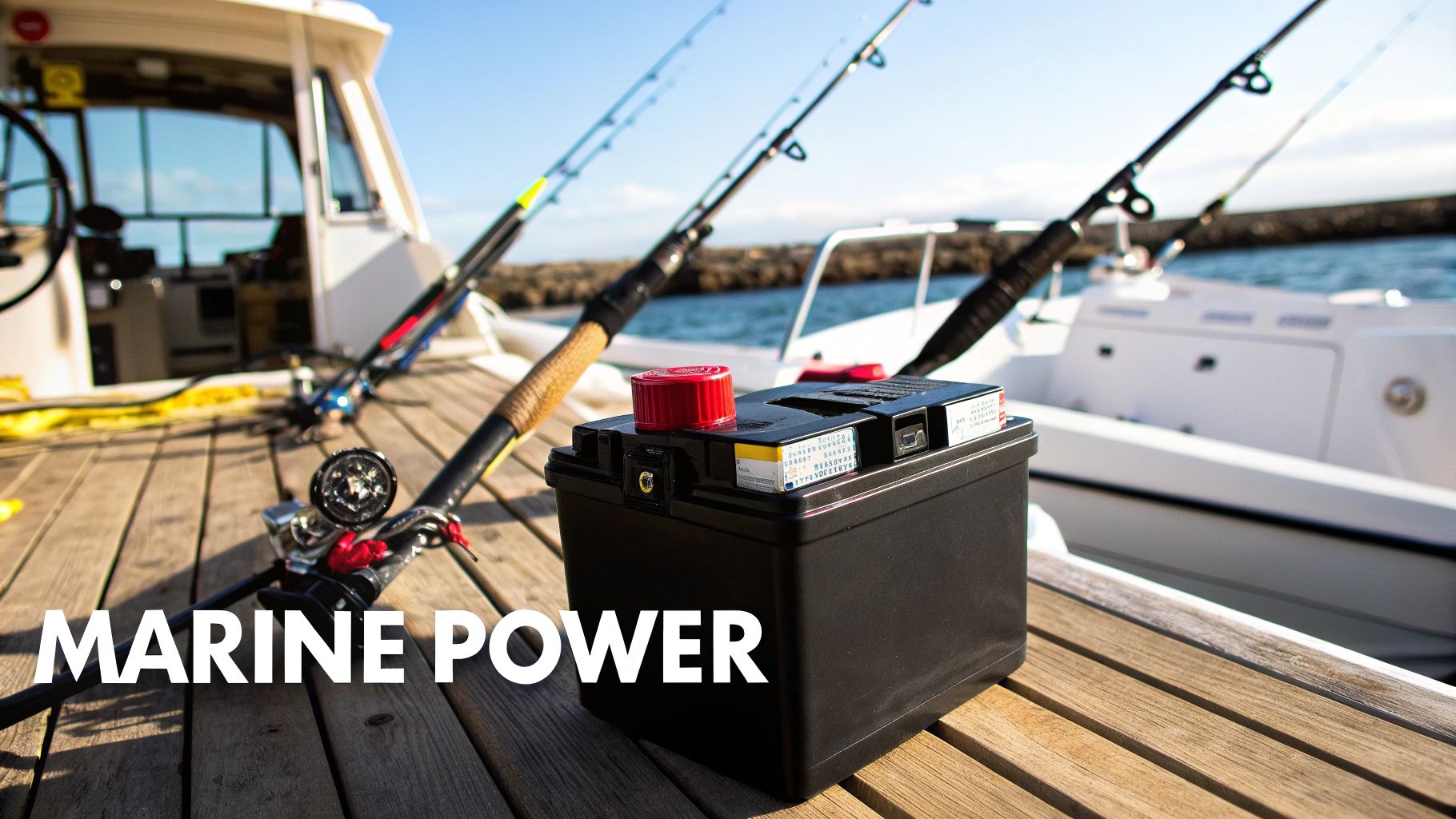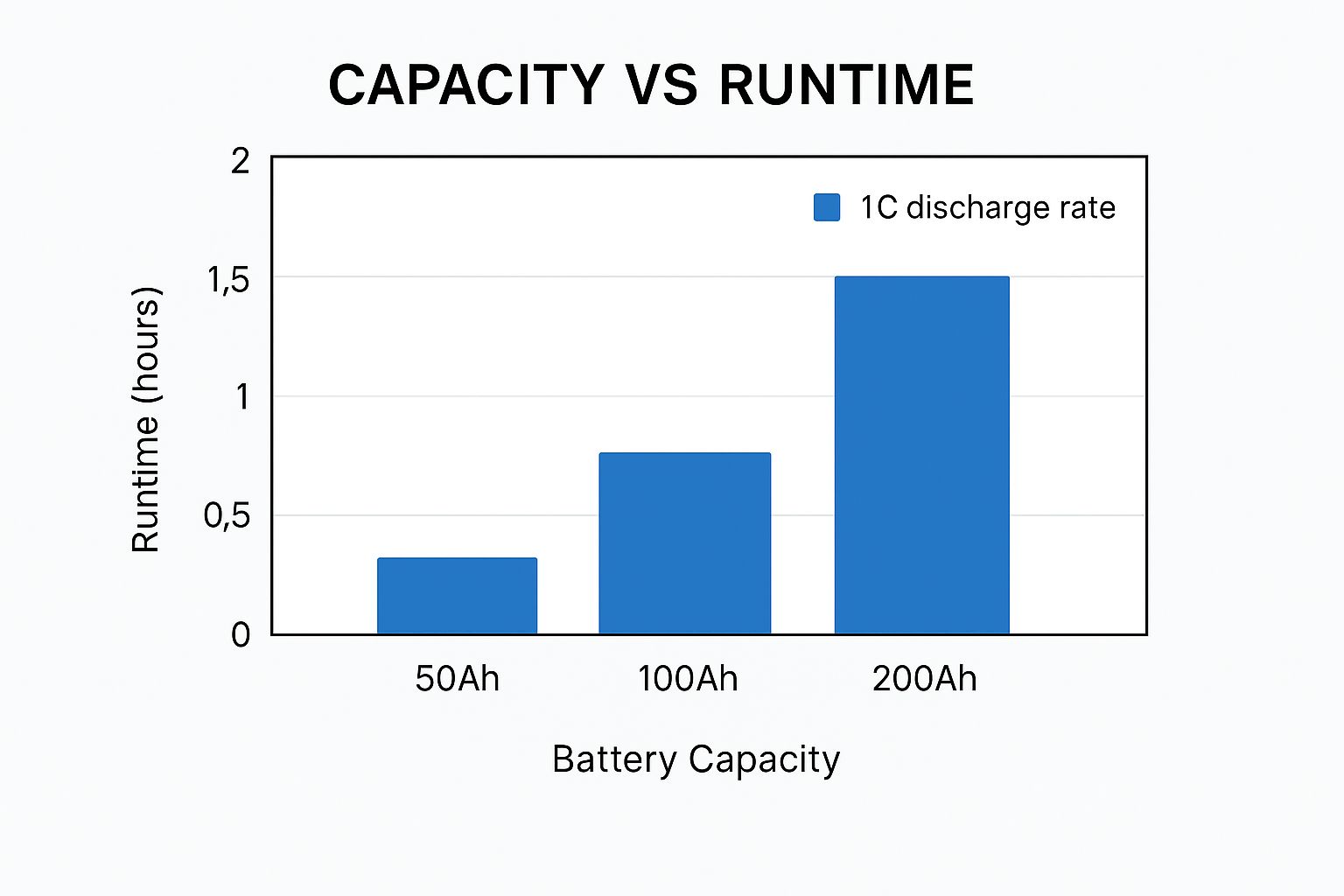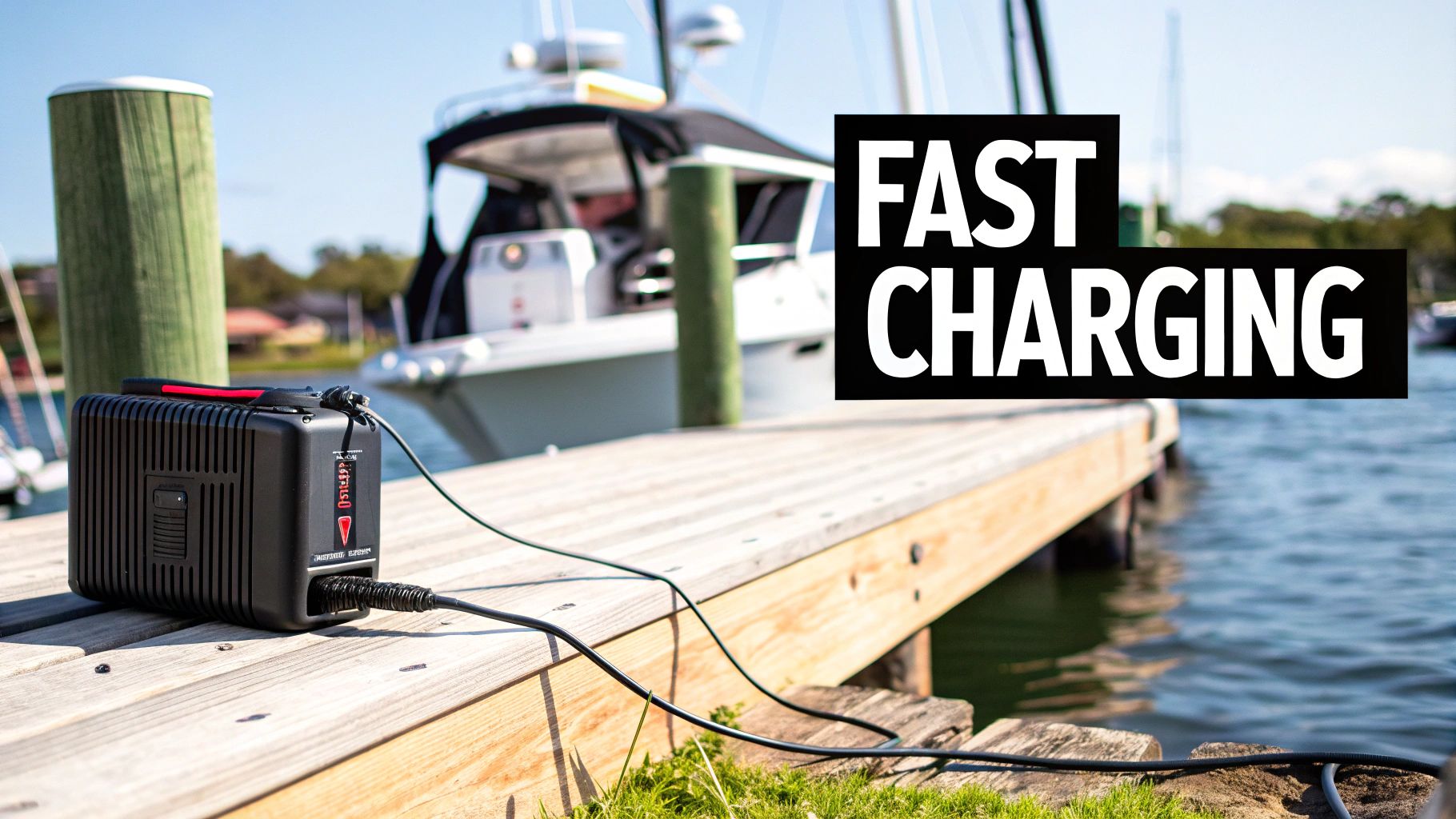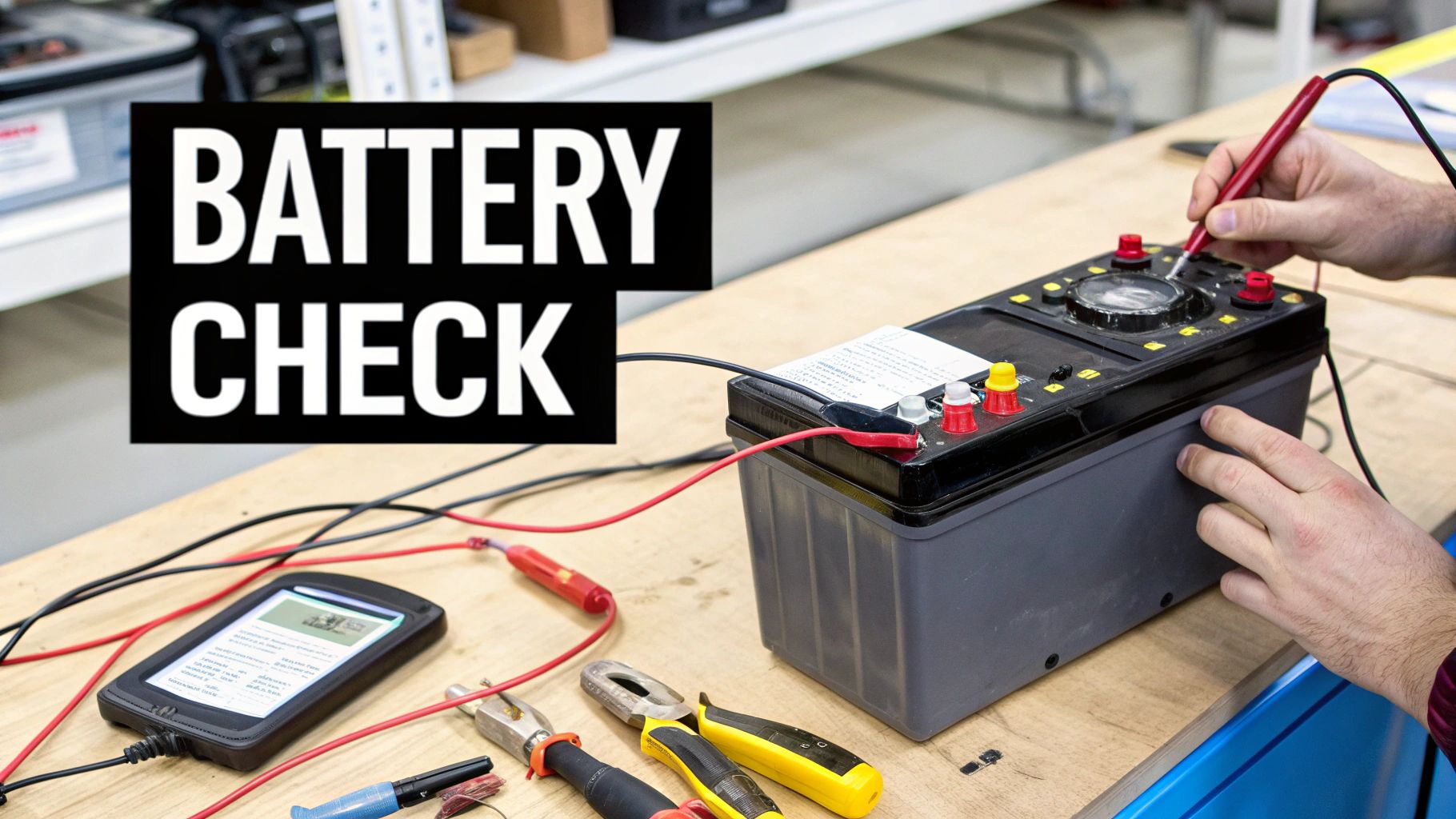Deep Cycle Marine Battery Guide: Power Your Boat Adventures
Understanding Deep Cycle Marine Batteries: Your Boat's Power Foundation

Think of your boat's electrical system. Your car battery provides a short, sharp burst of energy to start the engine. A deep cycle marine battery, on the other hand, is the steady, reliable power source that keeps everything humming along – from your fish finder on Lake Rotorua to your cabin lights in the Bay of Islands.
This key difference dictates everything from the battery's internal design to how you use and maintain it. Your car battery delivers a high current surge for starting and then recharges quickly. A deep cycle marine battery, however, is built to be discharged slowly and deeply over a longer period. Imagine the difference between a sprinter and a marathon runner.
Why "Deep Cycle"?
The term "deep cycle" describes the battery's ability to be repeatedly discharged to a low level without being damaged. Discharging a car battery past 50% can cause problems. A deep cycle marine battery, though, can handle being discharged to 80% or even more, hundreds of times throughout its life. This resilience makes it perfect for powering essential equipment on long trips or while you're anchored offshore.
Deep cycle marine batteries have a long history of vital service in New Zealand waters. While regional data is hard to come by, we can look at the global marine battery market for context. In 2021, this market, which includes deep cycle batteries, was valued at USD 348.2 million. And it’s expected to keep growing. You can find more details on the market here: Polaris Market Research.
Real-World Applications in NZ Waters
Whether you're chasing kingfish off North Cape or relaxing at anchor in a quiet bay, your deep cycle marine battery keeps everything running smoothly. It powers crucial equipment – navigation lights, bilge pump, fish finder, radio, and cabin lights – ensuring your safety and comfort on the water. For further information about marine radio, consider reading: About VHF Marine Radio.
Picture yourself anchored overnight in the Marlborough Sounds. Your deep cycle battery quietly powers your anchor light, making you visible to other boats. It also keeps a small fan running for ventilation. This constant, dependable power delivery is what sets a deep cycle marine battery apart. Choosing the right battery equips your boat for any situation, improving your time on the water and providing peace of mind on New Zealand's waterways.
The Chemistry Behind Marine Battery Performance: Why Technology Matters
Ever wonder why some marine batteries cost three times more than others? Or why your buddy's battery lasted five years while yours tapped out after two? The secret lies in the battery chemistry. Understanding these differences can save you headaches and cash down the line.
Each battery technology has its own distinct character. Think of flooded lead-acid batteries like that dependable old truck – needs regular tinkering but won't leave you stranded when properly maintained.
AGM batteries are your low-maintenance companions, consistently performing without much fuss. Gel batteries are specialists, thriving in specific conditions but requiring special care. Then there are lithium batteries, the high-performance sports cars of the battery world – expensive, but with impressive power and longevity. Knowing their strengths and weaknesses helps you choose the right battery for the job.
Decoding Battery Terminology
Let's demystify a few key terms, starting with depth of discharge (DOD) and cycle life. Depth of discharge simply means how much of the battery's stored energy you use before recharging. Picture your gas tank: running it near empty is a deep discharge.
Cycle life tells you how many times you can fully charge and discharge a battery before its performance starts to drop. A battery rated for 500 cycles at 80% DOD might be a smarter buy than a cheaper one rated for only 200 cycles. This means even though the cheaper option allows more frequent shallow discharges, the higher cycle count of the expensive battery makes it far more cost-effective over its lifespan. For more on this, check out Battery and Charging Technologies.
The NZ Marine Environment
New Zealand's marine environment, from Rotorua's geothermal waters to the salty Tasman Coast, throws unique challenges at batteries. Temperature swings, humidity, and vibration can all affect performance. Knowing how these conditions impact different battery chemistries is crucial for choosing a deep cycle marine battery that can handle the local environment.
The global deep cycle marine battery market is also booming. These batteries are specifically built to endure harsh marine conditions, which is especially important in a maritime nation like New Zealand. Market projections estimate significant growth by 2032. Learn more here. Choosing the right type ensures reliable power for your on-the-water adventures.
Matching Chemistry to Your Needs
Whether you're fishing in the Bay of Plenty on weekends or cruising around the North Island, the right battery chemistry is essential. Understanding the strengths and weaknesses of each type lets you make a smart decision that maximizes your time on the water and protects your investment. Picking the right battery isn't just about getting power; it's about ensuring reliability, safety, and enjoyment on every boating trip.
Choosing The Right Deep Cycle Marine Battery Type For Your Needs

The infographic above shows how battery capacity relates to how long it lasts (runtime) at a 1C discharge rate. Think of this as how long your battery can power your gear at a constant draw.
As you can see, runtime is directly linked to capacity. A 50Ah battery gives you 0.5 hours, a 100Ah battery runs for 1 hour, and a 200Ah battery powers things for 2 hours. Basically, double the capacity, double the runtime. This is really important when planning longer trips on your boat.
Flooded Lead-Acid Batteries: The Dependable Workhorse
Flooded lead-acid batteries are the old reliables of the marine world. They’re like that trusty old ute that just keeps going with a bit of TLC. Just like checking the oil and giving your ute a wash, these batteries need regular water level checks and the occasional terminal cleaning.
This makes them perfect for boaters who enjoy getting their hands dirty. If you like tinkering with your boat's systems and want a cost-effective, dependable solution, flooded lead-acid is a solid choice. Their affordability and proven track record make them a favourite for many Kiwi boaters.
AGM Batteries: The Low-Maintenance Option
AGM (Absorbent Glass Mat) batteries are for those who value convenience. Think of them like a modern car with electronic fuel injection – reliable performance without the constant fiddling.
Sealed and vibration-resistant, AGMs are built to handle New Zealand's varied boating conditions, from calm lakes to choppy coastal waters. Their tough build also makes them great for boats that are frequently trailed or face rough handling. If you're a busy boater who wants reliable power without spending weekends on battery maintenance, AGMs are a great fit.
Gel Batteries: Power in Demanding Situations
Gel batteries are the specialists, built for situations where you need a deep discharge. Imagine them as the four-wheel-drive of batteries, ready to tackle the tough stuff.
This makes them popular with serious fishers who run electronics all day long. Picture yourself drifting for hours with your fish finder and sounder going – a gel battery can deliver that sustained power. They do need specific charging profiles, though, and tend to be pricier than flooded or AGM batteries. So, they’re a less common choice but a valuable one for those who demand reliable power in challenging situations.
Lithium Batteries: The Premium Choice
Lithium batteries are the cutting edge of marine battery technology. They're like upgrading from a standard outboard to a high-performance engine, offering significant gains in performance and lifespan.
They’re lighter, more compact, and offer a much longer cycle life than other battery types. Plus, you can discharge them much deeper without shortening their lifespan. The upfront cost is higher, but the long-term benefits – extended lifespan, reduced weight, and superior performance – can make them a worthwhile investment.
To help you compare the different types, we've put together a handy table:
Deep Cycle Marine Battery Types Comparison: This table compares different battery types, including cost, maintenance, lifespan, and performance, specifically for New Zealand boating conditions.
| Battery Type | Initial Cost (NZD) | Maintenance Level | Typical Cycle Life | Depth of Discharge | Best For |
|---|---|---|---|---|---|
| Flooded Lead-Acid | Lower | High | 300-500 | 50% | Budget-conscious boaters, occasional use |
| AGM | Moderate | Low | 400-600 | 80% | Convenience, moderate use |
| Gel | Moderate to High | Medium | 200-300 | 70% | Demanding applications, deep discharges |
| Lithium | Higher | Very Low | 2000+ | 90% | Long lifespan, lightweight, high performance |
This table gives a general overview. Actual prices and performance can vary between brands and specific models, so it's always a good idea to do your research before buying. Suppliers like Battery World offer a wide range of options and can provide expert advice. You can also check out brands like Century Batteries for more information on marine batteries.
Calculating Your Power Needs: Getting Battery Sizing Right

Picking the right battery for your boat is crucial. Too small, and you're stuck; too big, and you're hauling around extra weight. This section helps you figure out the sweet spot for your deep cycle marine battery. Think of it like figuring out the right size fuel tank for your road trip.
Auditing Your Power Consumption
First, take stock of everything on your boat that runs off your deep cycle marine battery. This includes everything from your navigation lights to your fish finder.
Then, find out how much power each device draws (measured in amps). This information is usually on a label on the device or in the manual.
Next, estimate how many hours per day you use each gadget. Your navigation lights might be on for 10 hours overnight, while your fish finder might be on for 4 hours while you’re chasing snapper. Multiply the power draw (amps) by the usage hours to get the daily amp-hour (Ah) consumption for each device. This is like figuring out how much fuel you use on an average day of driving.
Typical Kiwi Boating Setups
Let’s take a look at a few examples. Small LED navigation lights might only draw 0.5 amps, sipping power like a small car. A powerful chart plotter or fish finder could draw 5 amps, more like a thirsty V8 engine. Over a 4-hour fishing trip, that's 20Ah drained from your battery.
To help you visualise this, we’ve put together a table showing typical power consumption for common marine electronics in NZ waters. This will give you a good starting point for calculating your own needs.
Before we get to the table, remember amp-hours (Ah) are like the size of your fuel tank, while reserve capacity tells you how long you can run on a full "tank."
Common Marine Electronics Power Consumption Guide: Realistic power consumption data for popular marine electronics used in New Zealand, helping you calculate accurate battery sizing.
| Device Type | Typical Power Draw (Amps) | Average Usage Hours | Daily Consumption (Ah) |
|---|---|---|---|
| LED Navigation Lights | 0.5 | 10 | 5 |
| Fish Finder | 5 | 4 | 20 |
| Bilge Pump | 10 | 0.5 | 5 |
| Cabin Lights | 2 | 5 | 10 |
| VHF Radio | 5 | 1 | 5 |
This table gives you a realistic idea of how much power different devices use. Use it as a guide to compare your own equipment and usage patterns.
Battery Bank Configurations
Sometimes, one deep cycle marine battery simply isn’t enough. You might need a battery bank, which is like having multiple fuel tanks for your boat.
Connecting batteries in parallel (positive to positive, negative to negative) increases your total Ah capacity. It's like adding extra fuel tanks, allowing you to run more devices or stay out longer without recharging.
Connecting batteries in series (positive of one battery to the negative of the next) increases the voltage. This is less common for everyday boating electronics but might be needed for specialized higher-voltage equipment.
Getting the right battery setup is all about accurate calculations. Don’t just rely on what the manufacturer says. Think about your own boating habits. Are you spending long weekends exploring the Hauraki Gulf, or are you making short fishing trips on Lake Taupo? Knowing how you use your boat helps you pick the perfect deep cycle marine battery, ensuring reliable power for all your Kiwi boating adventures.
Installation And Charging: Setting Up Your Power System For Success
Installing a deep cycle marine battery is just as crucial as mounting your outboard. Even the best battery won't perform well if installed incorrectly. This guide covers professional installation techniques to help you get the most out of your battery, especially in New Zealand’s challenging marine environment.
Mounting Your Battery: Secure and Stable
First, find a safe and secure spot for your battery. Think about easy access for maintenance and protection from the weather. The battery needs to be firmly mounted to prevent movement, especially in rough seas like those you might find crossing Cook Strait. A loose battery is a safety hazard and can damage the battery itself. Use sturdy marine-grade battery boxes and strong straps.
Ventilation: A Critical Safety Factor
Proper ventilation is essential, especially for flooded lead-acid batteries. These batteries release hydrogen gas during charging, which can be dangerous if it accumulates in a closed space. Make sure there's enough airflow around the battery compartment. This is important for all boats, from a small runabout on Lake Taupo to a launch in the Hauraki Gulf. Installing vents or fans can help, especially during charging.
Charging Your Deep Cycle Marine Battery: The Right Way
Charging is where many boaters go wrong, unintentionally shortening their battery’s life. A regular car charger isn't suitable for a deep cycle marine battery. These batteries need specific charging methods to perform well and last longer.
Smart Chargers: Your Battery's Personal Trainer
Smart chargers are the ideal solution. Think of them as a personal trainer for your battery. They carefully monitor and adjust the charging process, optimizing charging rates and stages. This helps extend the battery's life and ensures it’s always ready for your next trip. A good quality smart charger is a worthwhile investment for maximizing the lifespan of your deep cycle marine battery.
Solar Charging: Harnessing the NZ Sun
Solar charging is gaining popularity, particularly among environmentally conscious Kiwi boaters. Whether anchored in the Bay of Islands or cruising Fiordland, the sun can provide a consistent and free power source to keep your battery topped off.
Solar panel options range from simple portable panels for occasional top-ups to permanently installed systems for continuous charging. Think about how you use your boat and choose a solar setup that suits your needs and budget.
Combining Charging Sources: A Robust Power System
Many boats today utilize multiple charging sources. Your engine's alternator, shore power, and solar panels can all work together to keep your battery charged. Combining these creates a reliable power system, ensuring your battery is always ready, regardless of how you use your boat. This flexibility and backup power are essential for boating in New Zealand’s diverse conditions.
Maintenance And Troubleshooting: Protecting Your Power Investment

Just like your boat's engine needs a regular tune-up, your deep cycle marine battery needs some TLC to avoid expensive problems and keep it running smoothly for years to come. This guide walks you through practical maintenance, from simple checks to seasonal deep cleans, to ensure your battery stays reliable out on the water. We’ll also cover how to troubleshoot common battery hiccups.
Regular Maintenance: Small Steps, Big Rewards
Think of regular maintenance as a quick “doctor’s visit” for your battery. Begin with a visual inspection. Look for anything unusual like corrosion, cracks, or leaks around the terminals and casing. Corrosion, for example, can hinder performance and ultimately lead to failure. A simple cleaning with a wire brush and a protective spray can prevent this. These quick checks can save you from headaches later on.
Also, keeping your battery clean and dry prevents corrosion. New Zealand’s salty air can speed up corrosion, so wiping down your battery regularly is especially important if you’re boating in places like the Hauraki Gulf or the Bay of Plenty. This simple task only takes a few minutes and can significantly lengthen your battery's lifespan.
Seasonal Care: Preparing for Summer and Winter
Seasonal care is like giving your boat a thorough pre-season once-over. Before summer kicks off, fully charge your deep cycle marine battery and check its voltage. This ensures you're ready for those long days on the water. Likewise, proper winter storage is essential. Storing a fully charged battery in a cool, dry spot protects it from damage during the off-season.
Recognizing Warning Signs: Early Detection Is Key
Learning to spot the early warning signs can save you from being stranded with a dead battery. A sluggish engine crank on cold mornings or dimming cabin lights could point to a weakening battery. Similarly, if your fish finder is acting up or your bilge pump is running slower than usual, these could be signs your deep cycle marine battery needs attention. Addressing these early indicators can prevent bigger issues and extend your battery's life.
Specific Maintenance by Battery Type: Tailored Care
Different battery types have unique maintenance needs. Flooded lead-acid batteries, for instance, need regular top-ups with distilled water. This is because the water inside evaporates during use and charging. AGM and gel batteries, however, are sealed and don't need water top-ups. Lithium batteries have their own specific charging requirements and safety considerations.
Speaking of market trends, deep cycle marine batteries are becoming more popular in New Zealand as more people look for eco-friendly boating. The global marine battery market is expected to hit USD 1,897 million by 2030, growing at a CAGR of 19.8% from 2021. Learn more about these market trends.
Troubleshooting: Identifying the Problem
If you do run into battery problems, a systematic approach to troubleshooting can help you find the root cause. First, check the connections. A loose or corroded connection can cause voltage drops and other issues. Next, check the battery voltage with a multimeter. A low reading might indicate a discharged battery or a charging system problem. Finally, check the charging system itself to make sure it's working correctly. This step-by-step approach can often pinpoint the problem, saving you time and frustration.
Your Deep Cycle Battery Success Strategy
Now that you have a solid grasp of deep cycle marine batteries, let's talk strategy. This section helps you put that knowledge into action, guiding you through choosing, sizing, and maintaining the right battery for your boating lifestyle and budget right here in New Zealand.
Matching Batteries to Boating Styles in NZ
Think of it like this: a weekend fishing trip on Lake Taupo is very different from exploring Fiordland. Your battery needs will change depending on where you're going, the size of your boat, and the electronics you use. A small boat with basic electronics won't demand the same power as a larger vessel with high-powered fish finders and sound systems.
For a quick fishing trip on a Rotorua lake, a single, well-maintained flooded lead-acid battery might do the trick. But if you're planning a longer adventure in the Marlborough Sounds, with more reliance on electronics and perhaps cabin lights, you'll likely need a higher capacity AGM or even a lithium battery.
Choosing Suppliers: Navigating the NZ Market
Finding the right supplier is crucial. National chains like Repco and Super Cheap Auto offer a decent selection. However, for specialized advice or more complex setups, consider dedicated marine retailers or local battery specialists. They understand the specific demands of boating in our region and can provide tailored recommendations.
This screenshot shows the Battery World homepage, a familiar name in New Zealand. Their website showcases a range of batteries, including those for marine use, suggesting they're a good resource for boat owners. Their marine section likely offers more details on deep cycle batteries for different boating needs.
Creating Your Personalized Maintenance Schedule
Just like a car, your marine battery needs regular care. Think of your maintenance schedule as preventative medicine. If your boat sits unused over winter, proper storage is key. Fully charge the battery and store it in a cool, dry location. For year-round boaters, regular checks for corrosion and keeping terminals clean are essential, especially in our salty coastal environments.
Realistic Battery Lifespan Expectations
Knowing how long your battery should last helps you plan for replacements and upgrades. Flooded lead-acid batteries generally last 3-5 years with proper care. AGM and gel batteries extend that to 5-7 years. Lithium batteries offer the longest lifespan, potentially 10 years or more. Keep in mind, these are averages, and actual lifespan varies based on usage and how well you maintain the battery.
Staying Ahead of the Curve: Emerging Trends
Battery technology is always improving. New lithium chemistries are pushing the limits of performance and lifespan. Smart battery monitoring systems give you real-time data on battery health, allowing for proactive maintenance. Staying informed about these advancements ensures your investment remains a good one, keeping your boat ready for future adventures.
Are you ready to upgrade your boating experience with reliable power? Contact Mobile Systems Limited for expert advice and a wide selection of high-quality marine batteries and communication solutions throughout New Zealand. Visit us at https://mobilesystems.nz and let us power your next adventure!


